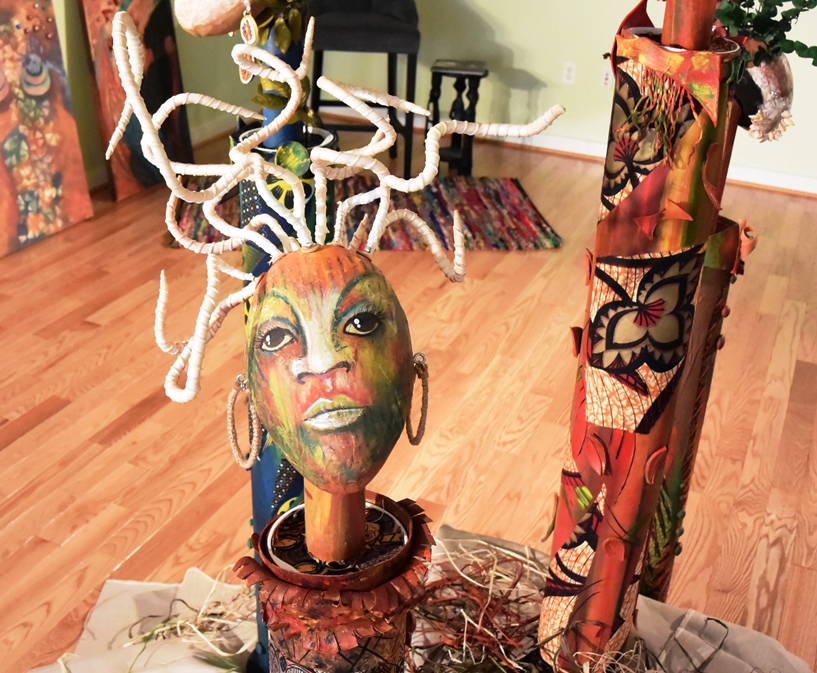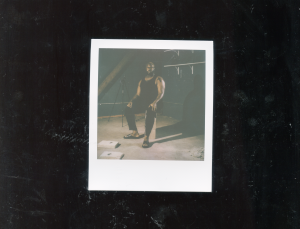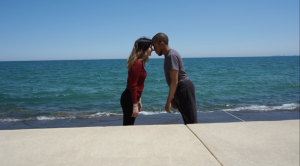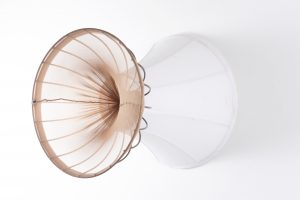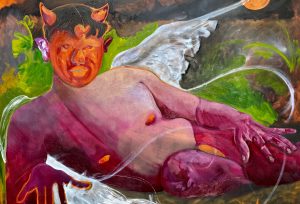1. Tell us a bit about yourself and your artwork.
I earned a fine arts degree from Southern Illinois University and a master’s degree from Chicago State University. I also studied at the School of the Art Institute of Chicago, the International School of Art and Design in Miami, Florida, and the Savanna College of Art and Design in Savanna, Georgia. I retired from a successful art teaching career, Art Curriculum Developer/Coordinator, Lead Teacher, Standards Based Curriculum Coach, and graphic artist for the Chicago Public Schools.
I exhibit collections of paintings and abstract assemblages which employing both vibrant and muted colors often infused with metallic accents. The sculptural nature of leather initiates large bas-relief assemblages. Found objects integrated into the pieces transform traditional uses. Leather’s ability to be mutilated and colored lends itself purposefully to sculpting. The use of exciting colors, overlapping construction, and original shapes, combine past cultures with contemporary forms.
I received numerous awards for my work from various institutions. My paintings, sculptures, and jewelry have been exhibited at the Neleh Art Gallery, Susan Woodson Gallery, Dixon School African Diaspora, Africa International House, South Side Community Arts Center, Art Institute of Chicago, Southern Illinois University, Chicago Cultural Center, African American Cultural Center (University of Illinois, Chicago), DuSable Museum, Chicago State University, South Shore Cultural Center, ISF, Sapphire and Crystals, Gallery Guichard, and several studio shows. As an art teacher, I taught with breath, wealth, and deliberation. As an artist, my work reveals the integrity of the human spirit, the sensitivities of life, the unity of family, the fidelity of friends, and pride in my African-American heritage.
2. How does living/working or being from Chicago influence your creative practice?
I love living in the City of Chicago. I was born here. I love the fact that art has influenced the growth of this city. I appreciate how urban planner Daniel Burnham and businessman A. Montgomery Ward designed around our beautiful beaches leaving them unblemished by buildings to enable the public to forever enjoy them. I appreciate how Chicago has embraced the arts by promoting every aspect of it which includes visual, performing, and the culinary arts. However I am truly disappointed at how our Chicago Public School system has chosen to reduce and /or eliminate art from the curriculum.
3. Describe the moment that you realized that you wanted to make art a career.
I wanted to make art my career when I was a small child. When asked I would answer, “An artist!” Subsequently when I went to college I never enrolled in any core classes without adding an art class to my schedule. I loved art and was quite good at it. I chose to major in art after I found that I had so many art credits that I made it my major.
4. Can you remember your first memorable encounter with a piece of artwork?
At five, I took ballet at the South Side Community Art Center. On my way down from the third floor I stopped to watch the children in the art class. The teacher persuaded me to enter, gave me paper and watercolors and instructed me to paint something. I intended to paint the image of the houses the way they looked from my bedroom window at night. I could see the houses and I could see the lighted windows. After sketching the houses and painting the windows yellow, I used black paint to paint the houses, the sky, and the ground. Needless to say, the windows remained and the houses disappeared. I was disappointed. The teacher said it was beautiful and insisted that I take the painting home. My parents loved the painting and hung it on the living room wall. I was convinced that it could be better. I studied the painting but I could not find a solution. One day I got so frustrated that I tore the painting from the wall and threw it in the trash. Since then I draw and paint every day. I still disappoint myself at times, but not often.
5. How have people responded to your work until this moment? Are you ever shocked by this response? How do you handle these responses?
Most people love my work; though difficult I try to appeal to the taste of everybody. I create works of art that are popular enough and appealing to a broad population but personal enough in that it draws upon my life experiences. I want people to stop, look, and read the messages that my paintings convey. I want the viewers to realize and enjoy the skill and passion that I use to execute my pieces. I believe that the job of the visual artist is to share, entertain, and inform.
6. Where would you like to see yourself and your work in the next 5 years?
I would like to see my work selected and recognized as a global phenomenon; something like a Susan Boyle (sic).
7. Do you remember the first piece of work you ever created in your career? How does it compare to the most recent?
The first piece of work I created was an acrylic of an African woman holding her infant son while sitting on a sandy landscape sifting grain for a meal. My work has evolved and changed throughout the years. My inspiration for using a host of artistic techniques is that I’d been an art teacher for most of my career. I started out painting with pastels. I love merging the chalky colors with my fingertips and how the individual particles of vibrant colors reflected the light. I often paint with acrylics, blending the colors often applying flat areas of color. I often introduce rich accents of metallic accents.
I discovered leather while creating wearable art pieces (jewelry). I was impressed with leather’s ability to be cut, wetted, twisted, heated, glued, mutilated, formed, and colored. This sculptural nature of leather soon initiated larger bas-relief assemblages and sculptures. Found objects were integrated into the pieces to transform and embellish.
8. Shameless plug: What are you doing right now? What shows are you in or preparing for? What series of work are you investigating, starting or thinking about starting?
I am working on a series for the next Sapphire and Crystals show at the South Side Community Art Center. The show will commence on September 2, 2010. The reception for the Postcard Show will be September 11, 2010 at 5:30-8:30 pm. The Special Collectors View the paintings at 4:00 to 6:00 pm. I will be exhibiting at the Alumni Show at Chicago State University. The reception for that show will be on September 11, at 1:30 pm. I have recently joined the group of artists at Artisans 21 at 1373 E. 53rd Street. I have a selection of my leather jewelry and several leather assemblages.
I want to open an art center on Chicago’s south side. I want to see artists’ work space, a gallery, a sales center, and space for teaching and demonstrations. I have noted a number of vacant and abandoned spaces but there is much work to do.
Learn more about Patricia Stewart’s work at http://wetpaintbrush.com
